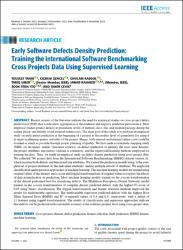| dc.contributor.author | Tahir, Touseef | |
| dc.contributor.author | Gencel, Cigdem | |
| dc.contributor.author | Rasool, Ghulam | |
| dc.contributor.author | Umer, Tariq | |
| dc.contributor.author | Rasheed, Jawad | |
| dc.contributor.author | Yeo, Sook Fern | |
| dc.contributor.author | Cevik, Taner | |
| dc.date.accessioned | 2024-01-25T05:09:38Z | |
| dc.date.available | 2024-01-25T05:09:38Z | |
| dc.date.issued | 2023 | en_US |
| dc.identifier.citation | Tahir, T., Gencel, C., Rasool, G., Umer, T., Rasheed, J., Yeo, S. F., & Cevik, T. (2023). Early Software Defects Density Prediction: Training the International Software Benchmarking Cross Projects Data Using Supervised Learning. IEEE Access, 11, 141965-141986. | en_US |
| dc.identifier.issn | 21693536 | |
| dc.identifier.uri | https://doi.org/10.1109/ACCESS.2023.3339994 | |
| dc.identifier.uri | https://hdl.handle.net/20.500.12294/4034 | |
| dc.description.abstract | Recent reviews of the literature indicate the need for empirical studies on cross-project defect prediction (CPDP) that would allow aggregation of the evidence and improve predictive performance. Most empirical studies predict defects at granularity levels of method, class, file, and module/package during the coding phase, and thereby avoid external failure costs. The main goal of this study is to perform an empirical study on early defect prediction at the beginning of a project at the product level of granularity for using it as input in planning quality activities of the project. Hence, both internal and external failure costs could be avoided as much as possible through proper planning of quality. We first made a systematic mapping study (SMS) on secondary studies (literature reviews) on defect prediction to identify the most used datasets, the project attributes and metrics utilized as estimators, and the supervised learning methods employed for training the data. Then, we made an empirical study on defect density prediction using cross-project data. We collected 760 project data from the International Software Benchmarking (ISBSG) dataset version 11, which reported both defects and functional size attributes. We trained the prediction models using: i) the complete set of project attributes, ii) the individual attributes, and iii) multiple subsets of attributes. We employed classification and regression approaches of machine learning. The machine learning models are trained using original values of the dataset, and z-score and logged transformations of original values to explore the effects of data normalization on prediction. Most machine learning models trained on the z-score transformation of the dataset performed best for classifying defects. The Multilayer-Perceptron (Neural Network) model trained on the z-score transformation of complete dataset predicted defects with the highest F1-score of 0.89 using binary classification. The logged transformation and feature selection methods improved the results for multivariable regression. The multivariable regression predicted defects with the highest Root Mean Squared Error (RMSE) and R2 (r-squared) values of 0.4 and 0.9, respectively, with a subset of 11 features using logged transformation. The results of classification and regression approaches indicate that defects can be predicted with reasonable accuracy at the software product level using cross-project data. © 2013 IEEE. | en_US |
| dc.language.iso | eng | en_US |
| dc.publisher | Institute of Electrical and Electronics Engineers Inc. | en_US |
| dc.relation.ispartof | IEEE Access | en_US |
| dc.identifier.doi | 10.1109/ACCESS.2023.3339994 | en_US |
| dc.rights | info:eu-repo/semantics/openAccess | en_US |
| dc.subject | Cross Projects Dataset | en_US |
| dc.subject | Defect Prediction | en_US |
| dc.subject | Fault Prediction | en_US |
| dc.subject | Feature Selection | en_US |
| dc.subject | ISBSG Dataset | en_US |
| dc.subject | Machine Learning | en_US |
| dc.title | Early Software Defects Density Prediction: Training the International Software Benchmarking Cross Projects Data Using Supervised Learning | en_US |
| dc.type | article | en_US |
| dc.department | Mühendislik ve Mimarlık Fakültesi, Bilgisayar Mühendisliği Bölümü | en_US |
| dc.authorid | 0000-0001-9653-5832 | en_US |
| dc.identifier.volume | 11 | en_US |
| dc.identifier.startpage | 141965 | en_US |
| dc.identifier.endpage | 141986 | en_US |
| dc.relation.publicationcategory | Makale - Uluslararası Hakemli Dergi - Kurum Öğretim Elemanı | en_US |
| dc.institutionauthor | Cevik, Taner | |
| dc.authorwosid | AAD-9997-2022 | en_US |
| dc.authorscopusid | 37017221000 | en_US |
| dc.identifier.wosquality | Q1 | en_US |
| dc.identifier.wos | WOS:001131617800001 | en_US |
| dc.identifier.scopus | 2-s2.0-85179821066 | en_US |


















